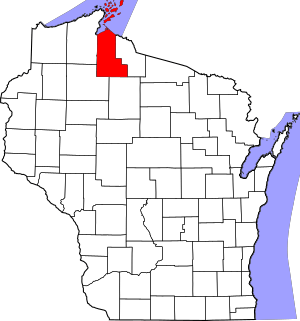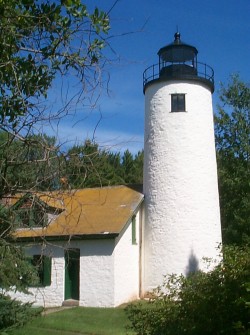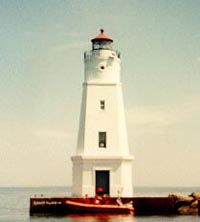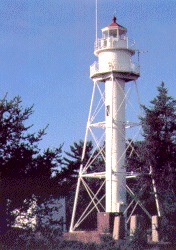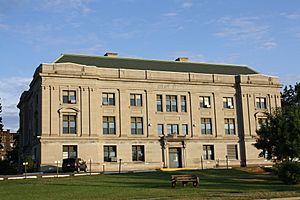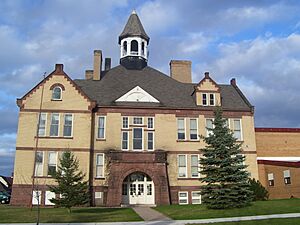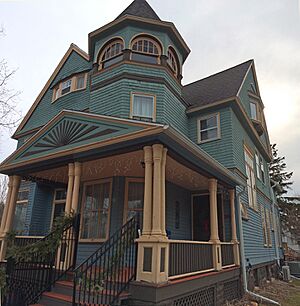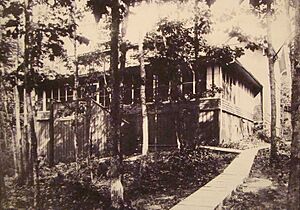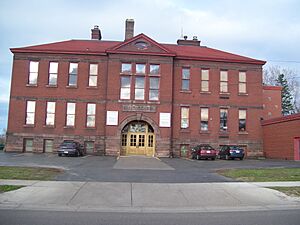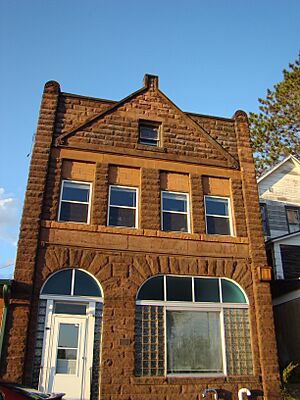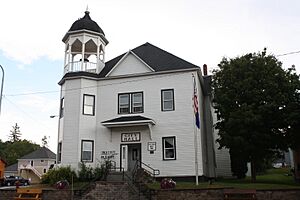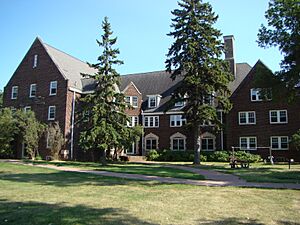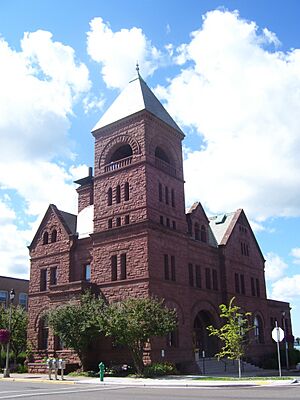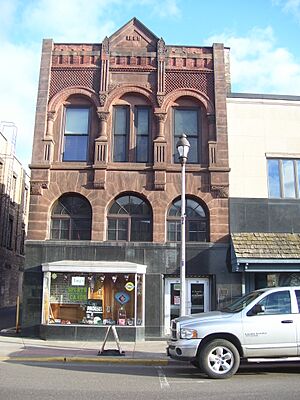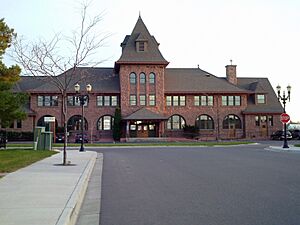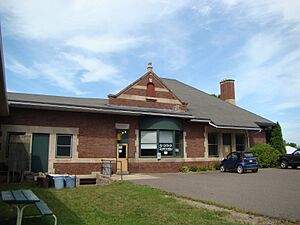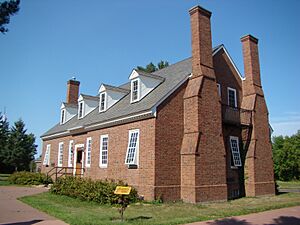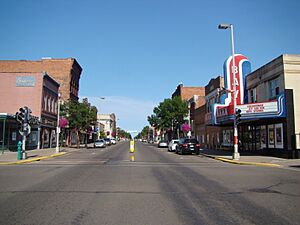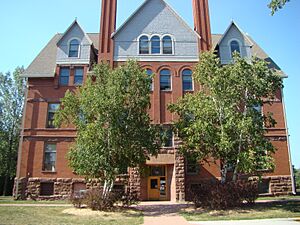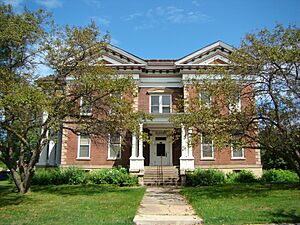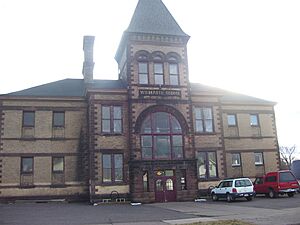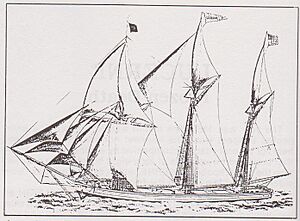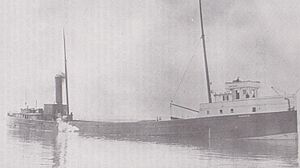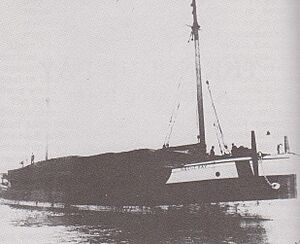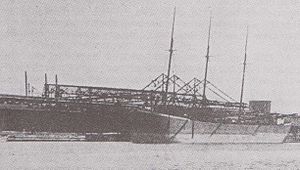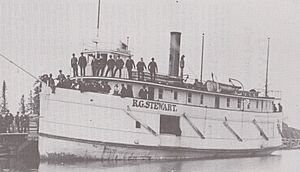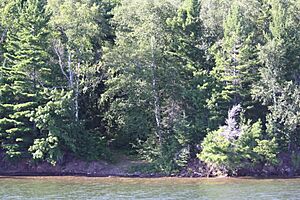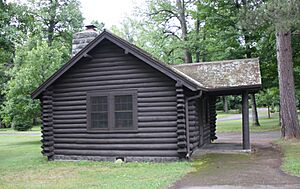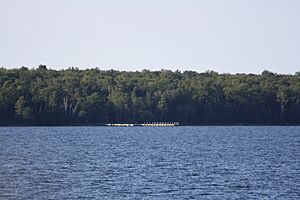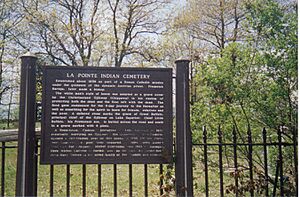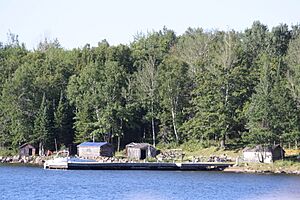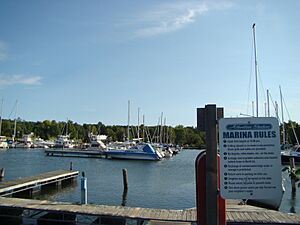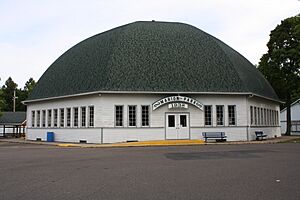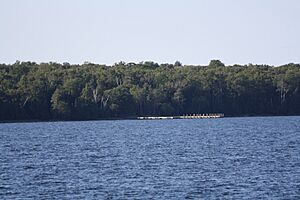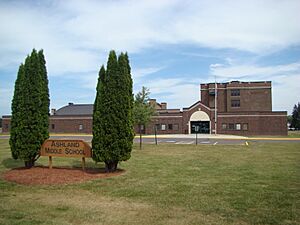National Register of Historic Places listings in Ashland County, Wisconsin facts for kids
Ashland County in Wisconsin is home to many special places that are listed on the National Register of Historic Places. This list helps protect buildings, sites, and objects that are important to American history, architecture, archaeology, engineering, or culture. Think of it like a VIP list for historical treasures!
There are 40 different places in Ashland County that have made it onto this important list. One place was on the list before but has since been removed. These sites tell us a lot about the past, from old lighthouses and schools to shipwrecks and Native American trading spots.
Contents
- Historic Places to Explore
- Amazing Lighthouses and Islands
- Old Buildings and Architecture
- Ashland County Courthouse
- Beaser School
- Chapple and MacArthur Avenues Residential Historic District
- Coole Park Manor
- Ellis School
- Glidden State Bank
- Mellen City Hall
- Memorial Hall (Northland College)
- Old Ashland Post Office
- Security Savings Bank
- Soo Line Depot
- Union Depot (Ashland)
- Wakefield Hall (Northland College)
- West Second Street Historic District
- Wheeler Hall, Northland College
- Lewis C. and Caroline Wilmarth House
- Wilmarth School
- Shipwrecks and Underwater History
- Historical Sites and Camps
- Other Important Sites
- Formerly Listed Places
- Images for kids
Historic Places to Explore
Here are some of the cool historic places you can find in Ashland County:
Amazing Lighthouses and Islands
Apostle Islands Lighthouses
These are six lighthouses located on different islands north and east of Bayfield. They were built starting in 1856. Their job was to guide ships safely through the Apostle Islands and around them. Imagine how important they were before GPS!
Ashland Harbor Breakwater Light
This is a 58-foot tall concrete tower at the end of a long breakwater in Chequamegon Bay. It was finished in 1915 by the United States Army Corps of Engineers. Its main purpose was to protect ships in the harbor that were loading iron ore from the nearby mines.
La Pointe Light Station
You can find this lighthouse on Long Island in Chequamegon Bay. It's a 65-foot tall tower that started guiding ore ships in 1895. Later, in 1939, a lightkeeper's house was added by the WPA (Works Progress Administration), a government program that created jobs during the Great Depression.
Old Buildings and Architecture
Ashland County Courthouse
This impressive three-story building was designed in a Neo-Classical style and built in 1915. It's where important county decisions are made and records are kept.
Beaser School
Built in 1899, this school building has a unique look with some brownstone features. It was designed by Henry Wildhagen, a local architect. Martin Beaser was one of the people who helped start the city of Ashland.
Chapple and MacArthur Avenues Residential Historic District
This area is a collection of 61 historic homes and buildings. They were built between 1888 and 1933 and show off many different architectural styles. You can see homes in the Shingle-style, Queen Anne, Gothic Revival, Stick style, American Foursquare, Craftsman, Dutch Colonial Revival, and Georgian Revival styles. It's like a walk through time to see how houses changed!
Coole Park Manor
This beautiful summer home overlooks Lake Superior. It was built around 1913 for a family from Kansas City. Imagine spending your summers here! It was later known as Chateau Madeline.
Ellis School
Another school designed by Ashland architect Henry Wildhagen, this building has a simple but classic Neoclassical design. It was built to serve the growing community.
Glidden State Bank
This bank building was constructed in 1905 and features a cool brownstone front. It was built in the Romanesque style, which often uses round arches and sturdy stone.
Mellen City Hall
Built in 1895, this city hall building is in the Queen Anne style, also designed by Henry Wildhagen. Over the years, it has been home to the police and fire departments, an opera house, a library, and now a museum.
Memorial Hall (Northland College)
This building was designed by Thomas Shefchik and built in 1928. It served as a residence hall and a common area for students at Northland College. It even had a root cellar attached!
Old Ashland Post Office
This large public building was designed by Willoughby J. Edbrooke and built between 1892 and 1893. It's made from local brownstone and was originally a post office. It has also been a vocational school and now serves as the city hall. Many people think it's one of the best examples of Richardsonian Romanesque architecture in northern Wisconsin.
Security Savings Bank
This bank was built in 1889 using brick and brownstone in the Richardsonian Romanesque style. It was designed by local architects Conover and Porter. Later, it was used by the Ashland Light, Power and Street Railway Company. In 1935, its lower outside walls were updated with black granite.
Soo Line Depot
This large brownstone train station was built in 1889 by the Wisconsin Central Railway. It's another example of the Richardsonian Romanesque style. Imagine all the travelers and goods that passed through here!
Union Depot (Ashland)
Designed by Charles Sumner Frost of Chicago, this train station was built in 1900 in the Queen Anne style. It's another important piece of Ashland's transportation history.
Wakefield Hall (Northland College)
Built in 1940, this Georgian Revival building was designed by Thomas Shefchik. It started as a library at Northland College and now houses offices.
West Second Street Historic District
This district includes 45 commercial buildings built between 1884 and 1937. They show a variety of styles and include places like the Blue Ribbon Bar, the Northern National Bank, and the Royal Theatre. It's a great place to see how businesses looked in the past.
Wheeler Hall, Northland College
This was the very first building of Northland College, originally called the North Wisconsin Academy. It was designed by H. P. Padley and built in 1893 in the Richardsonian Romanesque style.
Lewis C. and Caroline Wilmarth House
This grand Georgian Revival mansion was built in 1885 by Lewis Cass Wilmarth, who was Ashland's first banker. Later, in 1918, a hospital wing was added, and the mansion part served as the entrance and offices for Ashland General Hospital until 1972. Today, it has been turned into apartments.
Wilmarth School
Another public school designed by local architect Henry Wildhagen, this building was constructed in 1895 when Ashland was growing fast. It has a special Palladian shape and cool brownstone decorations.
Shipwrecks and Underwater History
BIG BAY SLOOP shipwreck
The remains of a small, unidentified sloop (a type of sailboat) are found about 300 feet from the shore of Big Bay State Park. It was probably built around 1880 and now rests under 25 feet of water.
LUCERNE (Shipwreck)
The Lucerne was a 195-foot, three-masted schooner built in 1873. On its last trip in November 1886, it was carrying iron ore from Ashland to Cleveland when it sank in a snowstorm. Sadly, all the crew members were lost.
MARQUETTE (shipwreck)
The Marquette was a 235-foot wooden bulk freighter built in 1881. On October 15, 1903, it was heading east with iron ore when it started leaking and sank. Luckily, the crew was able to escape safely.
MOONLIGHT shipwreck
The Moonlight was a beautiful sailing schooner built in 1874. In 1889, its top masts were removed, and it was turned into a barge. In September 1903, it sank in a storm while being towed with a load of iron ore out of Ashland.
NOQUEBAY (Schooner-Barge) Shipwreck Site
The Noquebay was a 205-foot schooner-barge built in 1872. On October 6, 1905, it was loaded with a huge amount of hemlock lumber and being towed when it caught fire and sank.
PRETORIA (schooner-barge) Shipwreck Site
The Pretoria was a massive 338-foot schooner-barge built in 1900. On September 1, 1905, it left Superior, Wisconsin, with iron ore and was caught in a big storm. It sank, and five crew members were lost.
R.G. Stewart (shipwreck)
This 100-foot wooden passenger steamer was built in 1878. On June 4, 1899, it got lost in a fog, ran aground on Michigan Island, and then caught fire. One crewman sadly died.
T.H. Camp (shipwreck)
The T.H. Camp was a steam-powered tugboat built in 1876. It was used to collect fish from faraway fishing camps. It sank in 1900.
Historical Sites and Camps
Bass Island Brownstone Company Quarry
This is where Lake Superior Brownstone was dug out of the ground from 1868 to the 1890s. This brownstone was used in many famous buildings, including the old Chicago Tribune Building.
Copper Falls State Park
This park features a beautiful gorge where ancient people, known as the Copper Culture people, likely mined copper a very long time ago. The state park itself was developed in the 1930s during the Great Depression by programs like the Works Progress Administration and Civilian Conservation Corps, which created jobs.
Hadland Fishing Camp
Christian Hadland, an immigrant from Norway, started this fishing camp in 1938 on Rocky Island. He would fish there every year from late spring until fall. The site still has cabins, a shed for storing nets, an ice house, and tools for fishing.
La Pointe Indian Cemetery
This cemetery was started in 1836 by the Catholic mission in La Pointe. Important figures are buried here, including Chief Great Buffalo, who signed treaties for the Ojibwe people with the U.S., and Michel Cadotte, a Métis fur trader.
Manitou Camp
This remote island camp on Manitou Island was used by men who logged and fished there since the 1890s. It includes old cabins, sheds for twine, and fishing tools.
Marina Site
This site is believed to be an old Indian village and cemetery, possibly from the 1700s and 1800s during the fur trade era. Some burials found here included copper bracelets.
Marion Park Pavilion
This unique eight-sided dance hall was built in 1938 with help from the WPA. It has a maple floor and a domed roof, designed by Frank Huber. Imagine dancing here!
Rocky Island Historic District
This district is a group of fish camps on the east end of Rocky Island. These small fishing businesses were run from 1938 to 1958 by families like Hadland, Benson, Edwards, Nelson, and Erickson.
Trout Point Logging Camp
This is the site of an old logging camp on Stockton Island. As many as 100 men worked here from the 1890s to 1920, cutting down trees for timber.
Winston-Cadotte Site
This site on Madeline Island is where the Ojibwe, Odawa, and Huron people might have traded with each other between 1600 and 1650. Later, it became the location of Michel Cadotte's trading post, from about 1790 to 1833.
Other Important Sites
Morty Site (47AS40)
This is an archaeological site. Its exact location is kept private to protect any historical findings.
P-Flat Site (47AS47)
Another archaeological site, its location is also kept private to protect its historical value.
Formerly Listed Places
Sometimes, a place that was once on the National Register of Historic Places is removed from the list. This usually happens if the building is changed too much, or if it is torn down.
Ashland Middle School
This school building was made of brick and brownstone in a Neoclassical style, designed by Henry Wildhagen. It was built around 1904 and served as a high school until 1973, then as a middle school. It was removed from the list in 2009.
Images for kids


